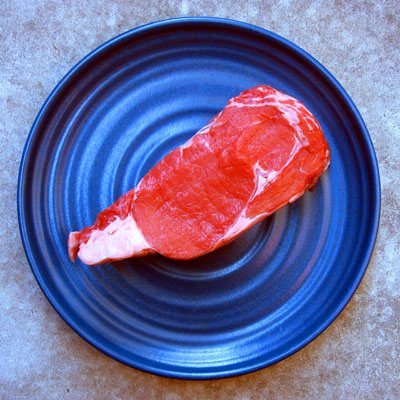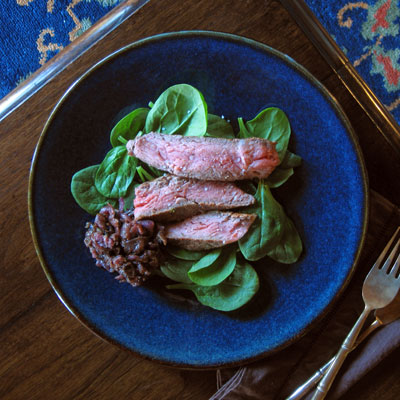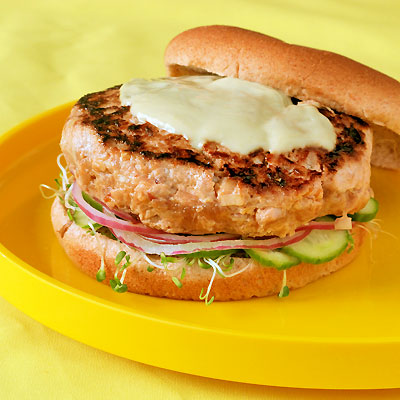
I over heard some people talking in a restaurant recently about steak. The point one of the diners was trying to make was that in tough economic times people turn from “better†cuts of meat to the “cheaper†cuts of meat.
His point made sense to me. I suppose people do exactly that.
But then his next statement floored me. He said, “So when I cook a steak at home I force myself to buy something like a flank or skirt steak. But when eating in a nice restaurant I always order the filet, no matter what the priceâ€.
I almost choked on my hanger steak!
I would advise just the opposite. While true that a good filet has a lovely soft tender texture. It cuts like “buttah” and we have been programmed to believe that means it tastes better. However, all filets, good, bad, or indifferent; cooked at home or at a Michelin starred restaurant are relatively flavorless. Why do you think people wrap them in bacon?
 Filets are best when broiled or grilled. Which is really not very hard.
Filets are best when broiled or grilled. Which is really not very hard.
A sauce to mask their rather bland taste often accompanies them. Filets are far easier for the home cook than are many other cuts of meat. Which, to me, means you are wasting your money when you order a filet in a very nice restaurant, especially in tough economic times.
If you are dining in a nice restaurant and craving some good red meat always order the cuts and preparations that are hard for the home cook to come by. A filet is a filet is a filet. I promise you. If you pick up a quality filet you can cook it yourself as well as any Food Network Star.
Now that I got that little pet peeve out of the way, let’s talk about cooking steak. Many people say that it’s hard to get a perfect steak unless you are willing to fire up the grill. Which for many of us is not always an option on any given Thursday. But I say “hog washâ€. A pan seared steak, finished in the oven is the utmost in simplicity and when done well can rival even the best steaks off the grill.
But before you cook a steak, you have to choose a steak. There are many factors, including cut. So for ease of discussion I am going to limit my comments to the rib-eye since most steak aficionados consider this the best all-around cut.
The rib-eye has more fat compared to the other cuts, which is why it’s such a tender, juicy, and flavorful piece of beef. It can be grilled, broiled, or pan-fried with equally delicious results. These steaks are actually cut from the same piece of meat used for the famous roast prime rib of beef. The leaner rib-eyes come from the small end and are a better choice for grilling. Otherwise I tend to go for the larger end of the cut.
For the very best flavor, look for the fat. Choose a steak that has plenty of marbling throughout the meat. You’ll see small flecks of fat, this fat gives the steak flavor, makes it juicy, and keeps it tender. However don’t confuse fat with gristle, look closely there is a difference.
Beef is commonly divided into three grades: prime, choice and select. The grades are determined by the amount of fat marbling in the meat and the age of the animal.
Prime contains the greatest amount of marbling throughout the meat. It can be difficult to find for the average consumer. Most of the grade is sold to better restaurants and select butcher shops. The price can be high, so be prepared to pay.
Choice is a mid-grade beef. It contains a moderate amount of marbling… just enough to make it tender and juicy. This grade can be found at most stores, and is the grade most likely to find its way to my table. Take your time when choosing, it takes thoughtful discrimination to find the steaks with the most marbling for the best flavor, juiciness and tenderness.
The select grade contains the least amount of marbling fat. The meat is the leanest of the three grades, so it’s a good choice for people restricting the amount of fat in their diets. However, the quality is variable. It might be tender, tough, juicy or dry. Without the fatty marbling in the meat, you just don’t know what you’ll be getting.
I have chosen a choice grade rib-eye. While it is not as marbled as I may have liked, it was very well-priced and extra thick. This baby is almost 2‑inches thick and is more than enough for two people. I find it much easier to properly cook thicker cuts of steak. Part of this is because I prefer my meat quite rare, but I do like a flavorful crust as well.
Pan searing is a great way to get just those results. This is the Alton Brown method, slightly adjusted for my kitchen. I warn you, it can be a rather dramatic way to cook a piece of meat. There will be quite a bit of smoking and sizzling. But this is a good thing, so turn the exhaust fan on and do not be tempted to lower the temperature! I am serving mine with a bit of glazed shallots and set on a bed of baby spinach, though arugula would be nice too. I am also going to make a flavorful “jusâ€, which will be the only dressing the “salad†needs.
Pan Seared Rib-Eye with Glazed Shallots serves 2 CLICK here for printable recipe
- 4 c shallots, thinly sliced
- 2 canola oil, plus another tablespoon separated
- 2 T unsalted butter, plus more as needed
- salt and pepper
- 1â„4 c sherry vinegar
- 1â„2 c dry red wine, divided
- 1 c flavorful stock (veal, beef, chicken, vegetable)
- 1 large rib-eye 1 1/2 inches thick
 SHALLOTS: Heat a 10–12 inch cast iron skillet over medium high heat. Add the butter and oil. Once the butter melts add all the shallots and stir to coat well. Turn the heat to medium. Season with salt and pepper. Continue stirring often so that the shallots cook evenly.
SHALLOTS: Heat a 10–12 inch cast iron skillet over medium high heat. Add the butter and oil. Once the butter melts add all the shallots and stir to coat well. Turn the heat to medium. Season with salt and pepper. Continue stirring often so that the shallots cook evenly.
After 5 or 6 minutes the shallots should be quite soft and beginning to caramelize. Taste for seasoning and adjust if necessary. Turn the heat down to medium-low and add the sherry vinegar. Continue to cook and stir until the vinegar is nearly reduced to nothing and absorbed into the shallots. Add 1/4 cup red wine and repeat the process. When the shallots have become somewhat “jammy†in consistency remove them from the pan and transfer to a plate.
Add the remaining 1/4 cup wine to the pan to de-glaze. Once all the bits of onion a have loosened from the bottom of the pan and the wine has reduced down to about 1 tablespoon add the stock. Continue reducing until about 1/2 cup of red wine “jus†remains. Pour this through a strainer and set aside in a warm place.
STEAK: Pre-heat the oven to 450 degrees F. Wipe the skillet you used for the shallots dry with a paper towel. Put the skillet in the oven. Let it get good and hot, about 15 minutes. Then carefully remove it from the oven and place on a burner set to high heat. Coat steak lightly with the remaining oil and season both sides with a generous pinch of salt and black pepper to taste.
Immediately place steak in the middle of hot, dry pan. Cook 1 minute without moving. Turn with tongs and cook another 30 seconds, then put the pan straight into the oven for 3 minutes. Flip steak and cook for another 3 minutes. (This time is for medium rare steaks. If you prefer medium, add a minute to both of the oven turns, rare a minute less…)
Remove steak from pan, cover loosely with foil, and rest for 4 minutes. Serve whole or slice thin and fan onto plate. Heap a generous helping of the glazed shallots onto the plate and some of the reserved “jus” on top.
SERIOUS FUN FOOD
Greg Henry
SippitySup



This boutique/shop/gallery space rocks. It has all the principles that make me want to root for this venture to succeed: conceived and managed by people from the neighborhood; not just promoting, but actually operating in an environmentally-conscious way; fabulous balance of edgy, classy, and accessible wares; and, serendipitously, I can walk there. 🙂
We are big supporters of eat local and community efforts! Congratulations on your wonderful achievement!
I have several friends who live around that area. I may just have to make a pit stop at the shop next time I’m around there. Those jellies do sounds good, too. Home-grown ingredients, it doesn’t get any better than that.
What a fantastic place! I try to seek out and support local artists and artisians as much as possible. I would much rather support small business owners who put their heart and soul into what they do!
Sounds like such a neat shop! I can’t wait to see what you do with your Jenkins Jelly!